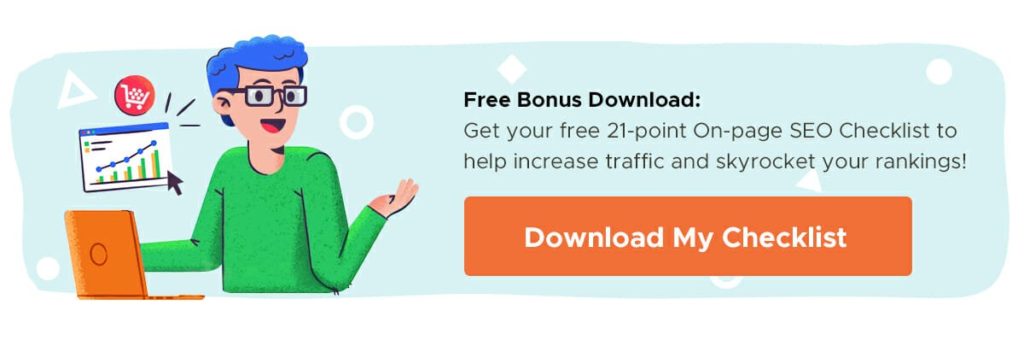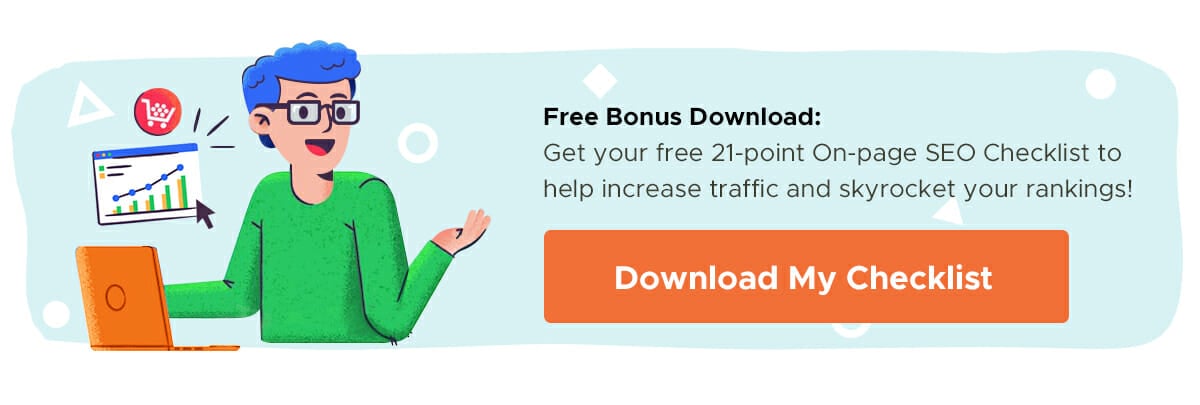Have you ever been sitting in a marketing meeting and felt baffled by the mysterious jargon or acronyms being tossed around the room?
Did you assume the person who said “What kind of content do we need for the TOFU?” was talking about a vegetarian lunch? Wondered if CTA and CTR were out-of-state television networks? Worried about plagiarism when a writer mentioned “copywriting”?
Like any other discipline, content marketing has its own lingo that may not always make immediate sense to newbies. Bookmark this handy list of content marketing glossary of terms, refer to it before you send off that Slack message, and soon you’ll be talking like a pro!
Because many content marketing terms overlap with general marketing, we’re going to keep this list to the fifty most commonly used content marketing terms that you should be aware of.
Above the Fold
The part of the web page that you see in your browser window when you first load a website is known as “above the fold.” This term harkens back to ye olde days of newspapers when above the fold literally meant the content that appeared above the crease in the paper when folded in half:

Online, it is the section that is first visible without scrolling down the page. The reason this section is so important is that because it’s the first (and possibly only) thing a readers sees, this content should be extremely engaging if you want your website visitor to keep reading/scrolling.
A/B Testing
Also known as split testing, A/B testing refers to the process of testing two variations of one specific element on your website, landing page, ad, etc. while keeping everything else constant in order to deduce which version is more effective.
For instance, you can try out two variations of the title of a blog post over a period of, say, two weeks, to see which one gets a higher click-through rate.
Dive Deeper: 5 Important Landing Page Elements You Should Be A/B Testing
Algorithm (Updates)
An algorithm is simply a set of rules that tells you how to perform a specific task, especially those done by a computer. A simple example of this is the recipe (set of rules) that you follow to bake a cake (perform a task).
In marketing, a search algorithm is a specific set of rules that a search engine follows to retrieve and analyze data to determine the relevance of web pages in accordance with the search query.
Typically, a major goal behind content marketing is improving your site’s rankings on the search engines, especially Google.
Because Google uses a fairly complex algorithm to value and rank content, they regularly make changes to their ranking algorithm and these are referred to as algorithm updates.
Dive Deeper: What Is the Google BERT Search Algorithm Update?
Analytics
Content marketing is not just about creative processes such as writing blog posts. You need to use some of that left brain juice, too, if you want to bring in better results.
Analytics is essentially the noun form of analyze and means the systematic and detailed examination of data. Why does a content marketer care about analytics? Well, as the old saying goes: What gets measured, gets improved.
Tools like Google Analytics allow you to measure your content output to determine if it is performing well and, if not, show you where you need to improve it to attract more traffic, get more shares, earn more conversions, etc. To learn more about what you should be measuring, see Key Performance Indicators (KPIs) below.
Dive Deeper: Google Analytics for Content Marketing: How to Track and Improve Your ROI
Attribution Models
People don’t usually just read an article on your blog and decide to do business with you. If only it were that easy! Rather, they browse your website and social channels, learn more about your business and, if all goes well, eventually convert into a paying customer.
So how do you know which of those marketing channels (blog, social media, emails, paid ads, etc.) contributed to the conversion and by how much? Enter attribution modeling, which is a part of the aforementioned analytics.
According to Google, an attribution model is the set of rules that determines how the credit for sales and conversions is assigned to touchpoints in conversion paths. That’s how you’ll know just how much business your content is actually generating.

Backlinks
Backlinks are hyperlinks from other websites that lead to your website. Generally, when it comes to backlinks, the more the merrier in terms of search engine rankings and traffic. However, the quality of links pointing back to your site or blog is equally important, if not more.
That is to say, a couple backlinks from high-authority websites far outweigh twenty links from low-authority or spammy websites.
Dive Deeper: The Skyscraper Technique: How to Build High-Quality Backlinks to Your Content
Bottom of the Funnel (BOFU)
Bottom of the funnel (or, as we hip pros call it: BOFU) is, literally, the bottom of a marketing funnel. It’s the “commitment” or “purchase” stage of the buying process of the customer.
When a person is at this stage, they’ve usually discovered a problem that they have, done some research on how best to solve that problem, and then narrowed it down to a few companies’ products or services.
See below for Top of Funnel (TOFU) and Middle of the Funnel (MOFU).
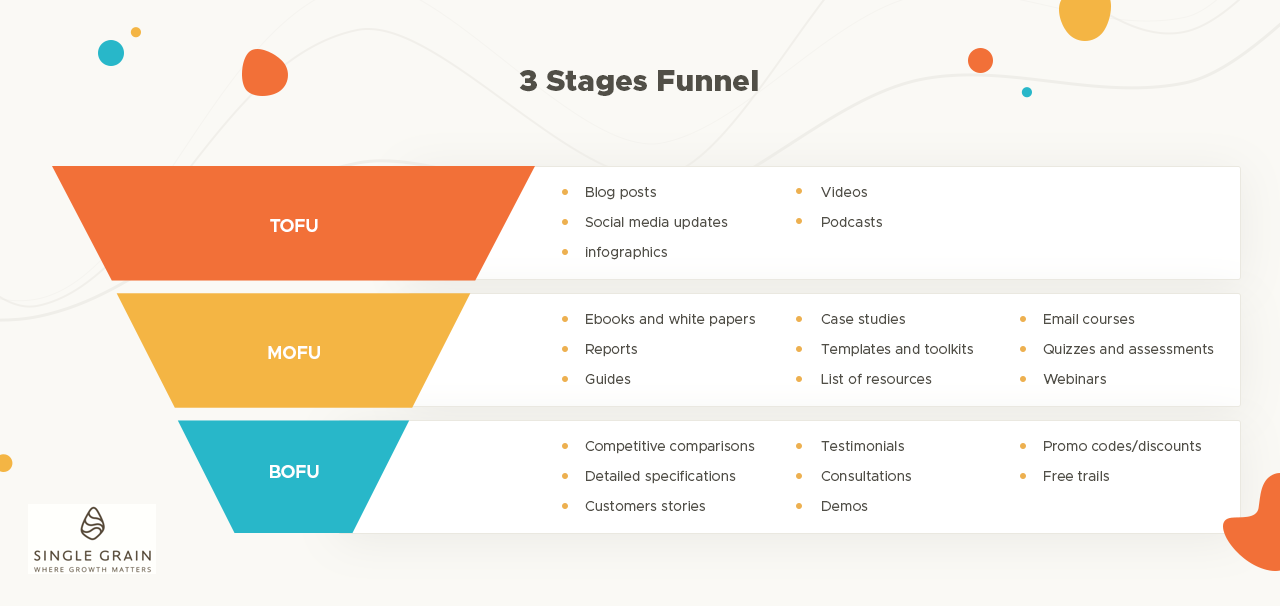
Dive Deeper: How to Create the Ultimate Marketing Funnel (Templates Included)
Bounce Rate
Bounce rate is the percentage of visitors who land on your website and then immediately leave (“bounce”) without engaging with the content or viewing any other page.
A high bounce rate (over 60%) may appear negative but it isn’t necessarily a bad thing. For example, if your website is primarily a blog and if the bounce rate for a post is higher than usual, maybe your visitors are getting exactly the answer they are looking for, which means a great user experience for them.
On the other hand, this may not be the reason, which is why it’s important to track and analyze your content’s data with Google Analytics or a similar tool.
Buyer’s Journey
As mentioned earlier, each customer you do business with has a unique path to conversion. The buyer’s journey is their route to that conversion, as they research your products or services, compare them with competing alternatives, and educate themselves before making a final purchase decision.
Prospects have different content requirements in different stages of their customer journey, and so it is important to tailor your content to each stage.
Dive Deeper: What’s the Right Content for Each Stage of the Marketing Funnel?
Buyer Persona
The buyer or customer persona is a vivid and detailed description of your ideal customers, based on customer data such as demographics, job title, behavior, pain points, motivations, etc. The more you know about your target audience, the more that knowledge enables you to create relevant and personalized content.
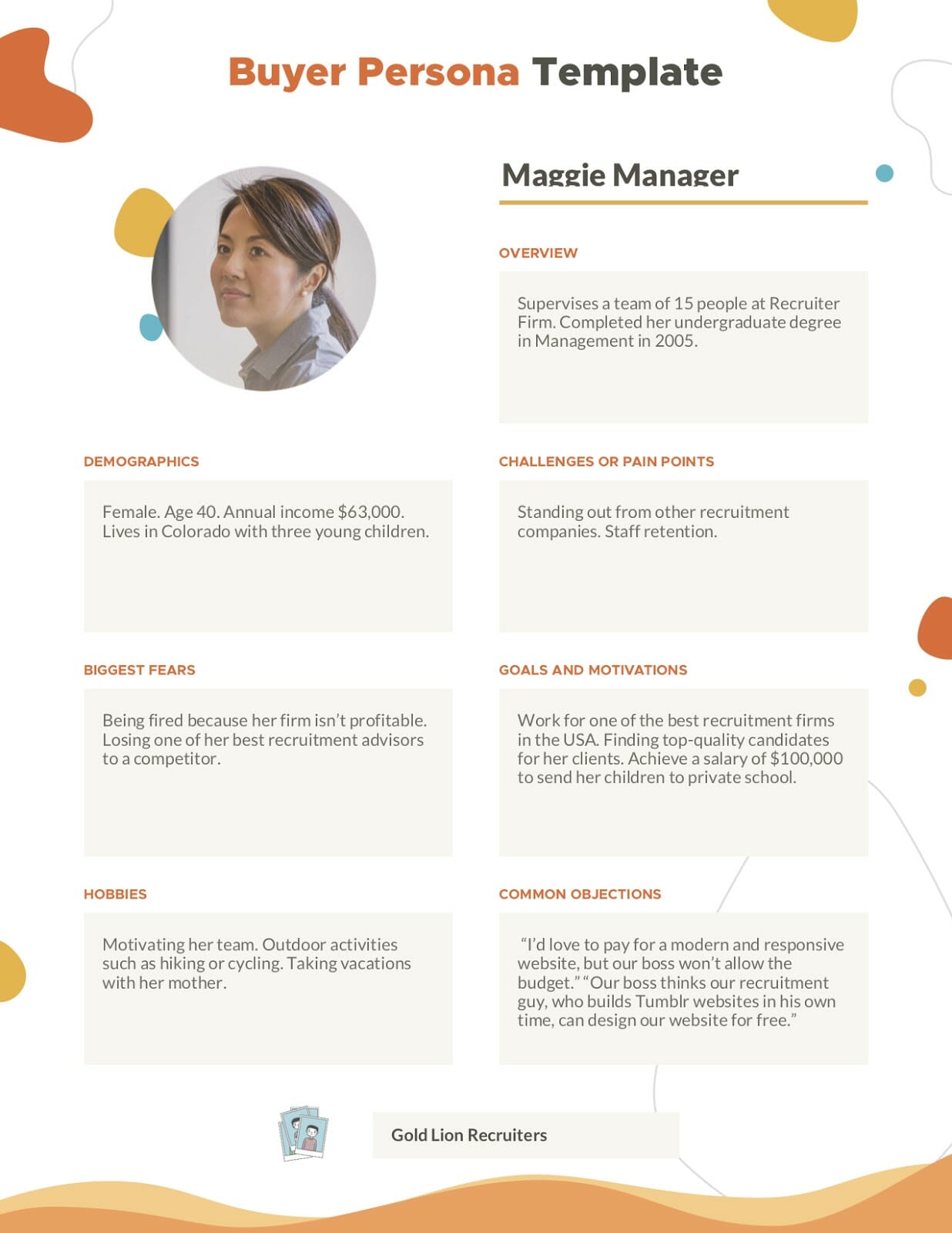
Dive Deeper: The Ultimate Guide to Developing Buyer Personas (with Templates!)
Call to Action (CTA)
A CTA is essentially a button or short and specific line of text that urges the user to take a desired action such as share your article, subscribe to your newsletter or download a PDF.
A call to action is typically one of the website elements that marketers A/B test to determine which copy, colors or position on the page gets the most clicks.
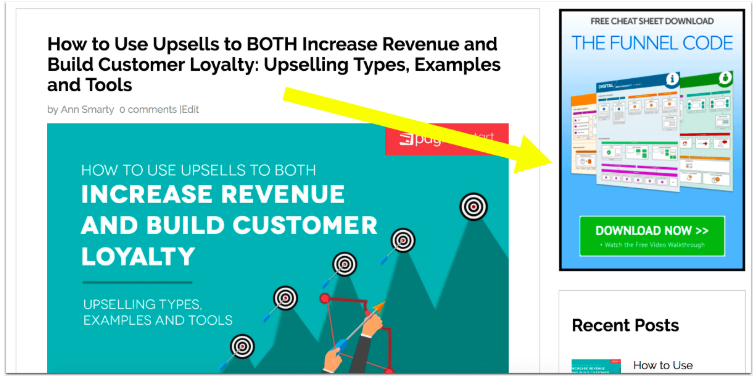
Dive Deeper: How to Create CTAs that Actually Cause Action
Click-Through-Rate (CTR)
CTR is the percentage of users who click on your link when they see it. So, if 100 people see your site’s link on Google and 10 people click through to visit your site, then the CTR would be 10%.
This data can help you understand which content titles and email subject lines grab more attention.
Content Audit
A content audit is a process of thoroughly assessing your content’s effectiveness and overall performance to see if changes can be made to boost results.
A detailed content audit done on an annual basis can give you great insights into your content marketing strategy.
Dive Deeper: The Step-by-Step Guide to Conducting a Content Audit
Content Curation
Content curation is the process of finding and assembling great content on a specific topic from various sources with the intent of providing value for your audience. Curated content often comes in the form of a roundup, and especially when curated by an expert, it can be very helpful for your audience who may not always know where to find this high-quality content – or simply not have the time.
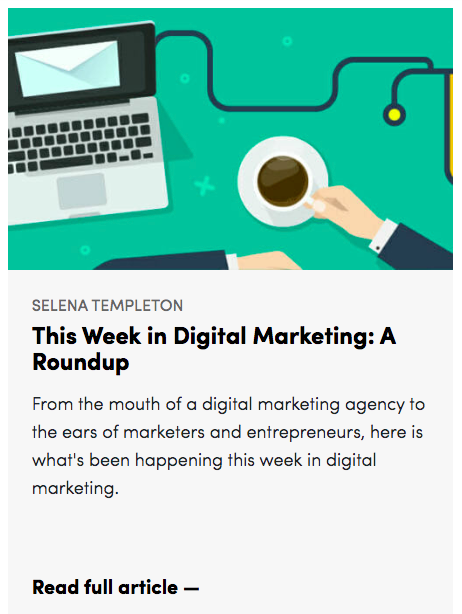
Content Management System (CMS)
A CMS is just a software that facilitates the publishing, editing and organizing of content. The most well-known and well-designed content management systems include WordPress and Squarespace.
Content Strategy
The process of strategizing all your content-related activities – everything from what to produce and when to the actual creation and promotion – is known as content strategy.
As content marketer Ana Gotter puts it: “Great content is nothing without a strategy behind it, and this is the biggest marketing mistake that I see brands consistently make…. A content marketing strategy is essential, and you should ideally have one in place before you start creating. Your strategy should take your business goal(s) into account so you can have a big-picture view of how you want to accomplish them.”
A good content strategy also includes the identification of appropriate channels that could be most effective in attracting and engaging prospects throughout their buyer’s journey.
Dive Deeper: How to Build a High-Performance Content Marketing Strategy
Copywriting
The actual writing of any marketing or advertising text (aka “copy”) is known as copywriting. Copy typically refers to textual content that’s intended to directly drive a desired action from the reader by highlighting benefits or features of your product/service.
In contrast, “content” itself usually refers to blog posts, images and videos that are informative, educative or entertaining in nature.
Editorial Calendar
Content marketing is all about consistently putting out solid content that’s super valuable to your audience. And to be consistent over the months and years, a properly planned calendar, known as an editorial or content calendar, is a must.
An editorial calendar outlines the topics you’ll cover, the content format (blog post, infographic, video, etc.), and when and where to publish each piece, thus helping you stay focused on your content marketing goals in the long run.
To create your editorial calendar, you can use a tool like CoSchedule or a simple spreadsheet like Google Spreadsheets.
Dive Deeper: How To Turn Your Editorial Calendar into a Well-Oiled Content Machine
Engagement
No, we’re not talking about your best friend’s wedding engagement! In marketing jargon, engagement refers to the ability to persuade your audience to interact with your content in a meaningful way, such as commenting on your post, sharing it on social media, answering your quiz – and, ultimately, buying your product.
Evergreen Content
Content that stays relevant and useful to your audience for years to come, rather than being topical or dated, is called evergreen content. The benefit of this type of content is that it has great SEO value.
Dive Deeper: How to Identify Evergreen Content Opportunities [podcast]
Gamification
Gamification is a way to make things more interesting for your audience by integrating game-like mechanics — awards, badges, leveling up, earning points, and ranking on leaderboards — to encourage engagement and brand loyalty.
For example, the Starbucks uses gamification with its mobile app that rewards you with free drinks and food items for achieving a certain amount of stars:
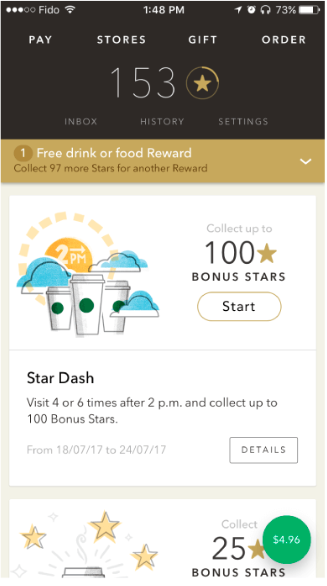
Gated Content
Gated content is exclusive, high-quality content that is not available to everyone who simply visits your website. Instead, it’s only accessible to visitors who are willing to exchange their valuable personal details (such as name and email address) for it.
Hosting gated content is a tried-and-tested way for increasing lead generation.
Guest Posting
An age-old way to earn backlinks (see “Backlinks” above) and higher brand visibility for your website is contributing quality articles to other websites and publications. This is known as guest posting and apart from improving rankings on Google, it also helps build trust with new audiences.
Here are several other benefits of guest posting:
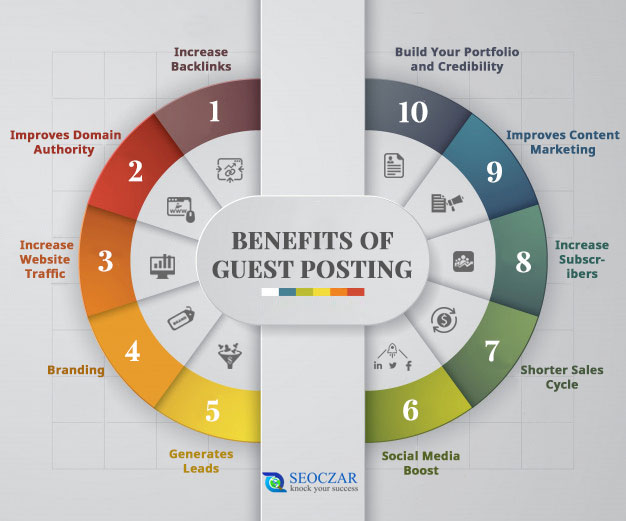
Dive Deeper: The Power of Guest Blogging (And How to Get Started!)
Hashtag
Social media platforms like Twitter and Instagram have popularized the use of the hashtag, which essentially is just words with a pound sign (#) in front of them. Hashtags are included in the captions of posts to associate them with similar content around the web.
Aside from being trendy, hashtags improve a post’s visibility, as you can search for hashtags on search engines or social media to find related content. For instance, you can search for #olympics to find all the content related to the Olympics on Twitter or Instagram.
Hypertext Markup Language (HTML)
HTML is the standard, universal language used to create every website or web page you see on the Internet. It is used to provide structure to a website’s content such as adding paragraphs, headings and images.
Here’s an example of the above paragraph in HTML:

For the majority of content marketers and bloggers, you’ll stick with the “visual” tab in WordPress and never venture into the “text” tab.
Inbound Marketing
Inbound marketing is an approach to marketing wherein you focus on creating useful content that attracts audiences to your website as opposed to using disruptive ads to forcefully get their attention.
Content marketing aligns perfectly with inbound marketing and both have the same goal of earning the audience’s trust by providing value.
Dive Deeper: What Is Inbound Marketing?
Infographic
Infographics are impressive visuals that provide information about a particular topic in a simple and easy-to-consume way. They are usually full of statistics and facts (rather than tons of text) intertwined with delightful illustrations to explain an idea elegantly and crisply.
Here’s an example of an infographic on content marketing:
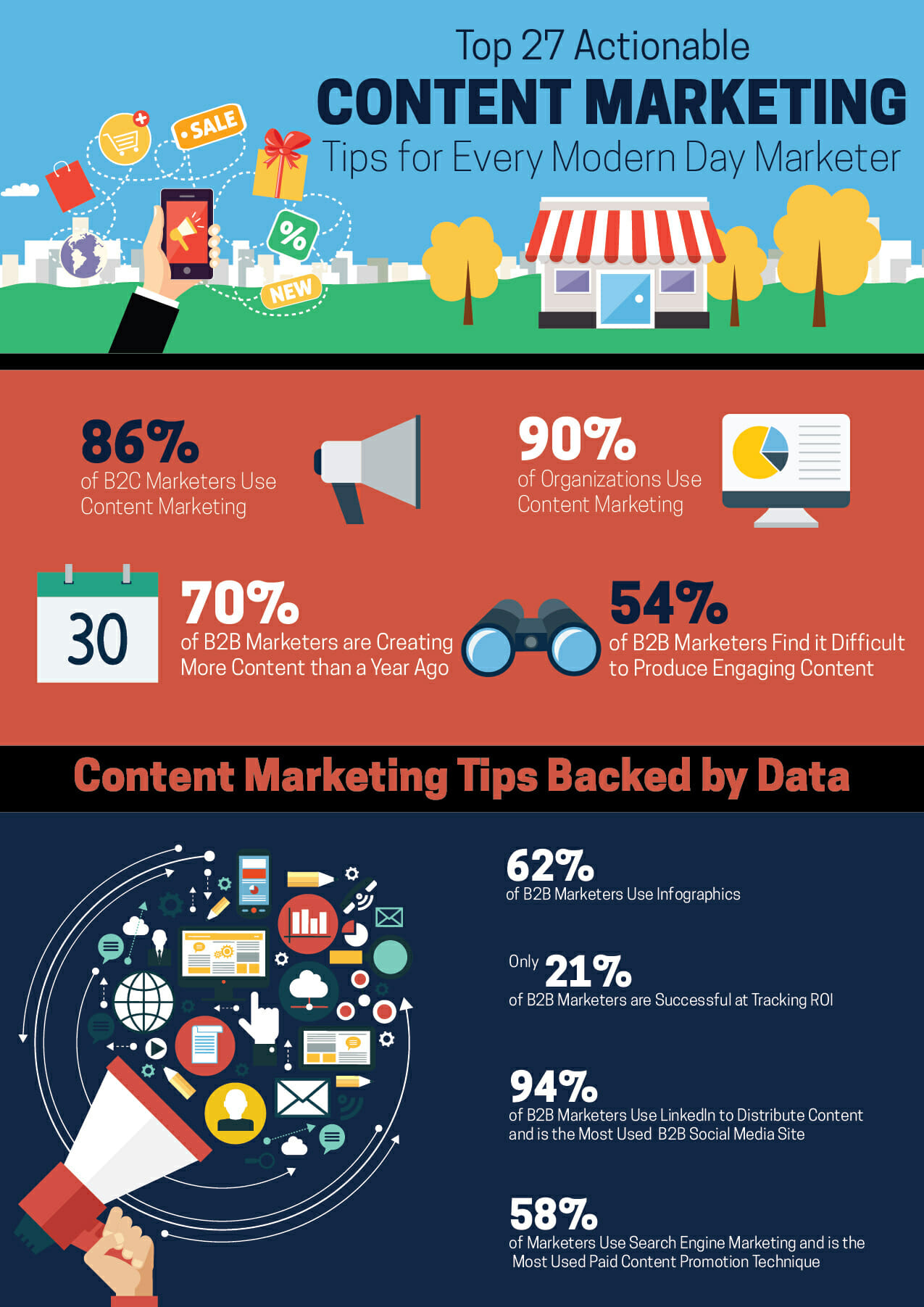
Keywords
A keyword is a word or short phrase that can be used to summarize the content of a web page. In terms of SEO, keywords are entered into the search bar by users to find content on a specific subject, and search engines make use of them to determine the topic of a web page. For example, the keyword of this blog post could be “content marketing” or “content glossary”.
The main keyword of a blog post or page is strategically placed in the title, subheadings and sprinkled throughout the content. However, overusing keywords can be seen as keyword stuffing and can hurt your search engine rankings.
Dive Deeper: Should a Blog Post Focus on One Keyword or Multiple Keywords for SEO?
Key Performance Indicators (KPIs)
KPIs are a set of quantifiable metrics, such as new users, cost per lead and click-through rate, that are used to evaluate your marketing performance against specific business goals.
Dive Deeper: Top Marketing KPIs that Every B2B Company Needs to Track
Landing Page
A landing page is a web page that is tailor-made to prompt visitors to take a specific action. It could contain a form meant to capture visitor information and convert them into leads, often by offering gated content such as a guide or white paper, in exchange for contact information.
Each landing page has a specific goal such as sell a product, watch a video or get newsletter sign-ups. The landing page can be very short or quite long, but it should only have one goal and one CTA.
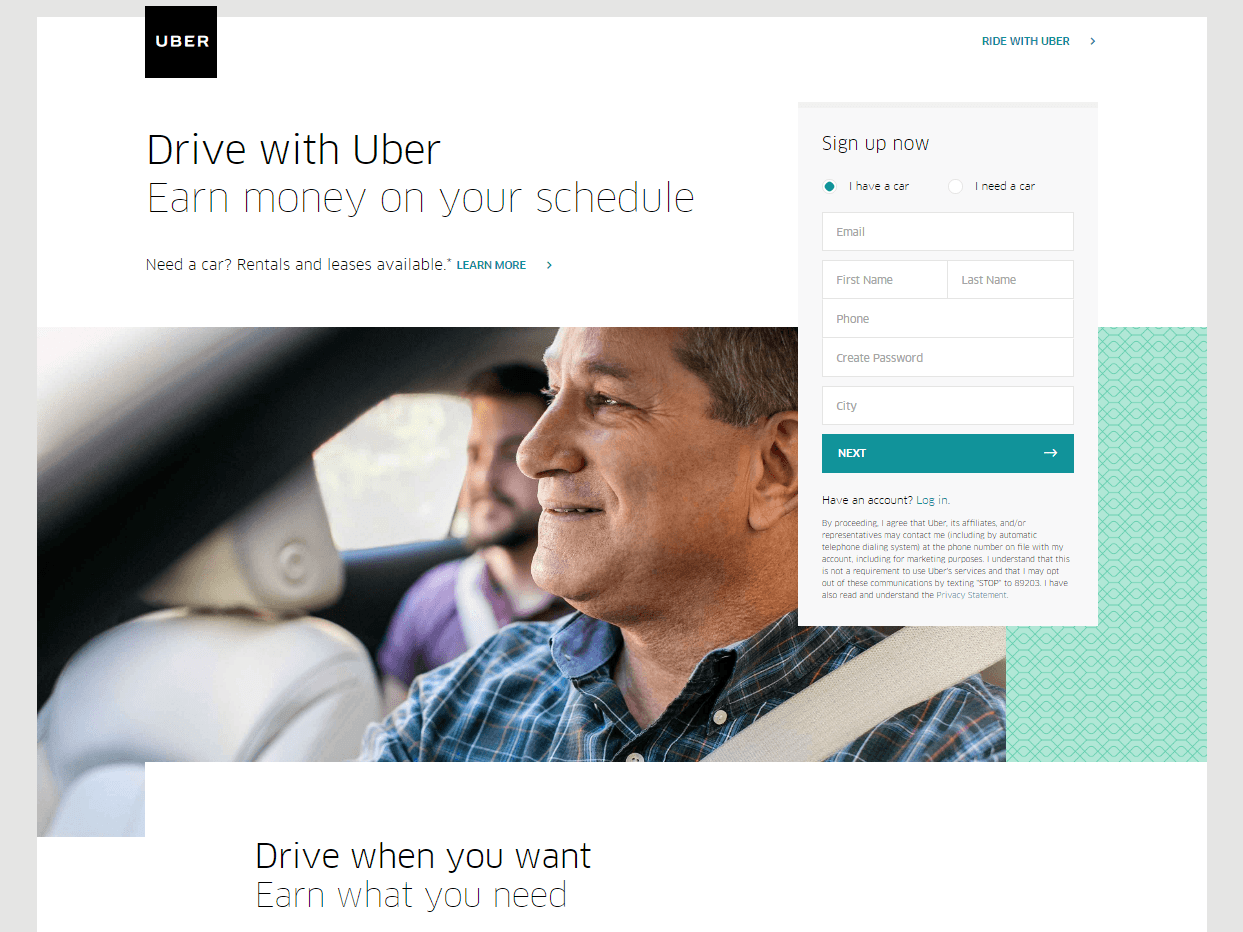
Dive Deeper: The Ultimate Guide to Creating a High-Converting Landing Page in 2020
Leads
Leads are people who have the potential to turn into paying customers or users for your business. In other words, these are people who show interest in what you have to offer by clicking on a call-to-action, thus providing their contact or personal information.
Contact marketing is excellent for lead-gen because, “unlike other lead generation strategies, content marketing gives to prospects, instead of asking them for something.”
Dive Deeper: Best Lead Generation Tactics for Content, Email & Social Media Marketing
Link Building
As mentioned earlier while discussing backlinks, links are the online content creators’ currency — the more, the better. Backlinks from high-authority and high-quality sites can help boost your website’s search engine rankings like nothing else.
Link building is the process of garnering more and more links to your site by various means such as guest posting, blogger outreach, promoting linkable assets (such as a detailed guide), and more.
Dive Deeper: The Marketer’s Guide to Link Building
Long-Tail Keywords
Long-tail keywords are more precise phrases rather than just one or two words. And the more specific a search query, the lesser the search volume is for that phrase, which means it is easier to rank on top for those specific phrases.
For example, “buy sports shoes” is a more generic keyword phrase, but a long-tail variant of it could be something like “best place to buy black running shoes” which if you incorporate strategically in your content, could easily lead to higher rankings on Google. Long-tail keywords are the best way to power up your SEO strategy.
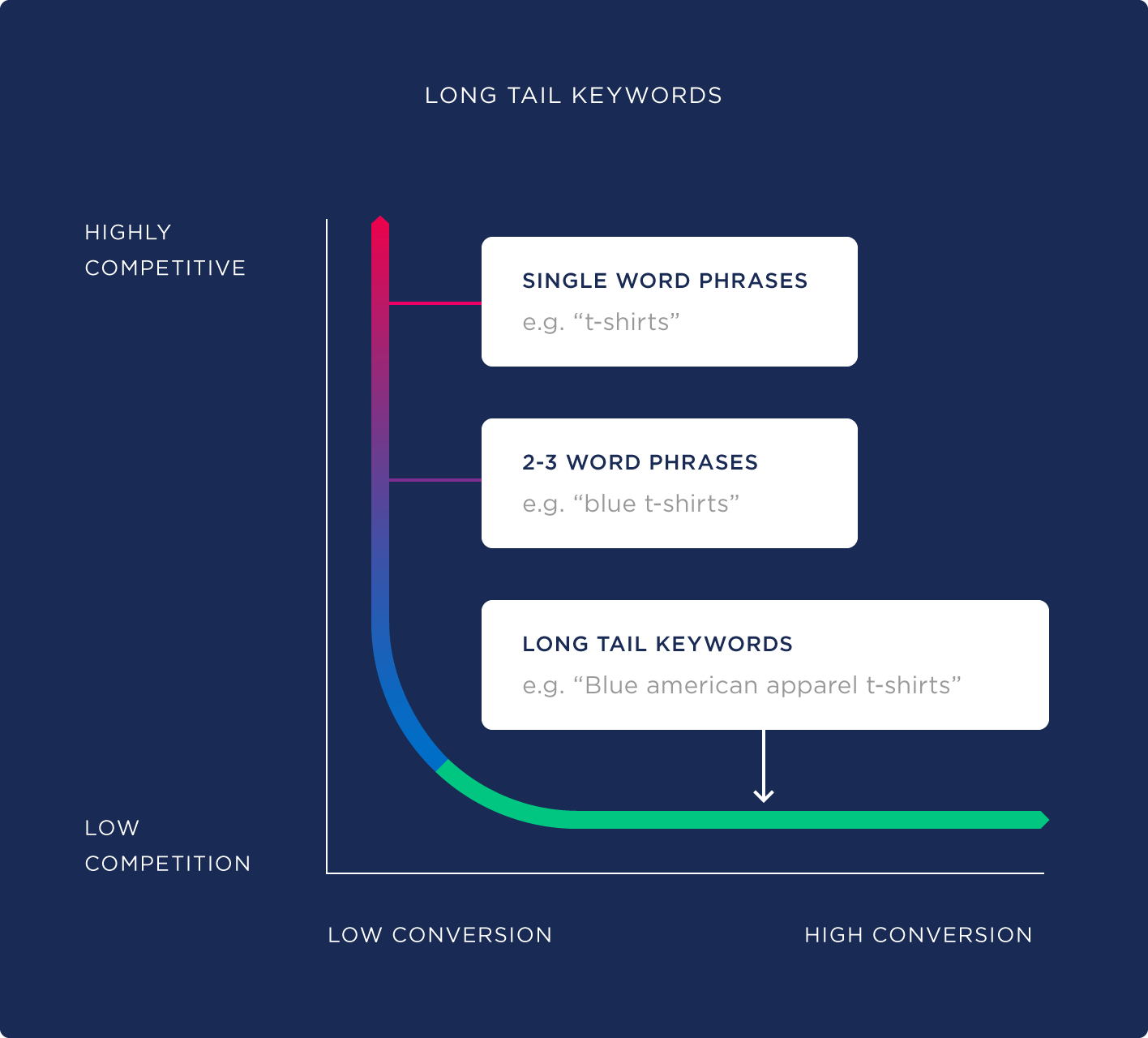
Dive Deeper: Why You Should Use Long-Tail Keywords in Your SEO Campaign
Metrics
Metrics are similar to KPIs in that they are quantifiable measures that track business performance. Key performance indicators, however, take this one step further by helping you assess whether you’re reached your goals, rather than simply track them. Here’s a quick look at the difference between metrics and KPIs:
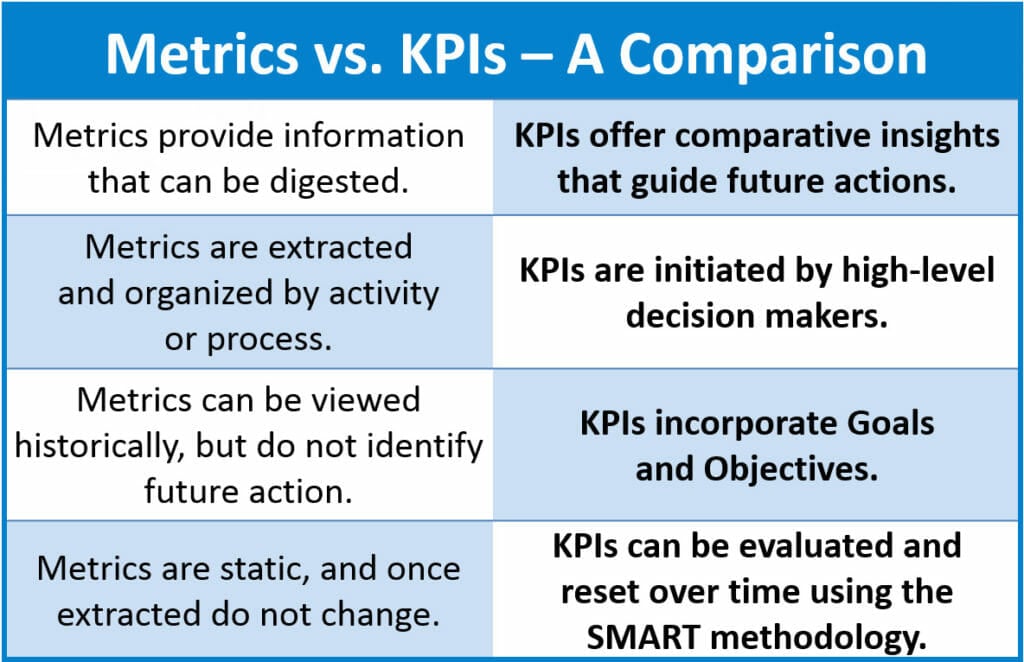
Middle of the Funnel (MOFU)
The middle of the funnel (MOFU) is just what it sounds like: the middle portion of a marketing funnel. It’s the “interest” or “evaluation” stage of the buying process of the customer.
When a person is at this stage, they’ve usually discovered a problem that they have, and are now researching options to solve that problem — but have not yet narrowed it down to the point of making a purchase.
See below for Top of Funnel (TOFU) and above for Bottom of the Funnel (BOFU).
Mobile-First Indexing
In 2016, Google updated their algorithm to crawl and rank the mobile versions of websites instead of the desktop versions, so if your mobile site isn’t up to their standards, you could be in big trouble traffic-wise.
Mobile ranking factors that create a positive user experience like fast loading and quality images will improve your rank. Mobile ranking factors that hurt user experience such as errors and hard to click buttons will lower your rank.
Dive Deeper: Mobile-First Indexing: What You Need to Improve Your Site’s Ranking
Newsjacking
When there’s a piece of breaking news that’s spreading like wildfire and you act promptly to create some valuable content around it, there’s a very high chance that your content will get a lot of attention. Your blog post might even get featured in news stories by journalists, which would boost your brand’s visibility exponentially.
Plus, as you’d expect, such content could rank high in search results and bring in a lot of instant traffic. Newsjacking is a great way to get brand awareness and social shares with little effort, as Oreo demonstrated with their now-classic Superbowl newsjacking.

Dive Deeper: How to Newsjack: A Guide for Content Marketers
Off-page Optimization
Like any other business, you want your website to rank high in search results. Off-page optimization refers to marketing activities that aren’t executed directly on your website but still facilitate better rankings and authority. Notable off-page optimization techniques include link building, commenting on blogs, influencer outreach, and forum posting.
On-page Optimization
On-page optimization, on the other hand, are those SEO techniques performed directly on a website to improve search engine rankings. This includes optimizing title tags, meta descriptions, internal links, content and URLs.
A strategic combination of off-page and on-page optimization is how most businesses build their online authority.
Owned Media
All the content controlled by your brand comprises all your owned media, and includes your website, blog and social media profiles. The content you contribute to other publications is not owned media, because that’s no longer completely in your control. Sure, it takes a lot of time and effort, but in the long run, owned media is a must for establishing sustainable online brand authority.
In comparison, organic media includes SEO, content marketing and social media posts (but not sponsored posts) and paid media refers to any content placed outside of your own real estate that you pay for, like PPC ads, display ads and search ads.
PageRank
PageRank is the name of the primary algorithm used by Google to rank websites in search results. It was named after Larry Page, the co-founder of Google. Even though the famous PageRank score is not publicly visible anymore, this algorithm is still considered the backbone that decides a web page’s relevance and importance in search results.
Personalization
Everyone appreciates personalized attention, and not one of your customers wants to be treated as one-size-fits-all customer. So tailoring your content to match specific segments of your audience can make a huge difference in your marketing ROI.
If you think of companies like Netflix or Amazon, you’ll understand just how effective personalization is: both these brands keep track of the movies you’ve watched or the products you’ve purchased (or even browsed) on their site and, based on that data, they send you specific and relevant recommendations that you might like.
Dive Deeper: How to Use Personalization to Increase the Impact of Email Marketing
Podcast
In today’s fast-paced life, people often lack the time to read text-based content. Many people would prefer to listen to your content while commuting, for instance. That’s where podcasts come into the picture. A podcast is just audio content you can listen to on-demand.
Launching a podcast is easy, but keeping at it while still putting out regular content on your website and social media can be challenging.
Dive Deeper: Podcast Production 101: The Complete Guide to Starting Your Own Show
Responsive Design
Responsive websites are those that automatically adjust all their content to the size of the device. A responsive design ensures that visitors have an equally good website browsing experience whether they’re on a large desktop computer or a tiny smartphone screen. If your site visitors have to pinch and zoom the screen or scroll horizontally, your website is not responsive.
Not only is it likely that more than half of your audience is using a mobile device such as a smartphone or tablet to consume your content, but a responsive website converts better than a non-responsive one.
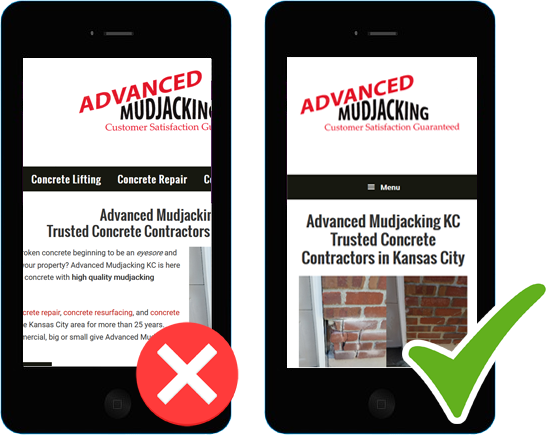
Search Engine Optimization (SEO)
Using the off-page and on-page optimization techniques outlined above to get your website ranking on the first page of the SERPs is known as search engine optimization, or SEO.
In other words, it is the practice of improving a website’s visibility in a search engine’s organic (unpaid) search results by building backlinks, including relevant keywords, publishing useful content, and so on.
Dive Deeper: 9 Effective SEO Techniques to Drive Organic Traffic in 2020
Search Engine Results Page (SERP)
The page full of links that a search engine delivers in response to a search query is commonly referred to as SERPs. Usually, each search engine entry consists of a title, a brief meta description of the content with words bolded that match the search query, and the website URL.
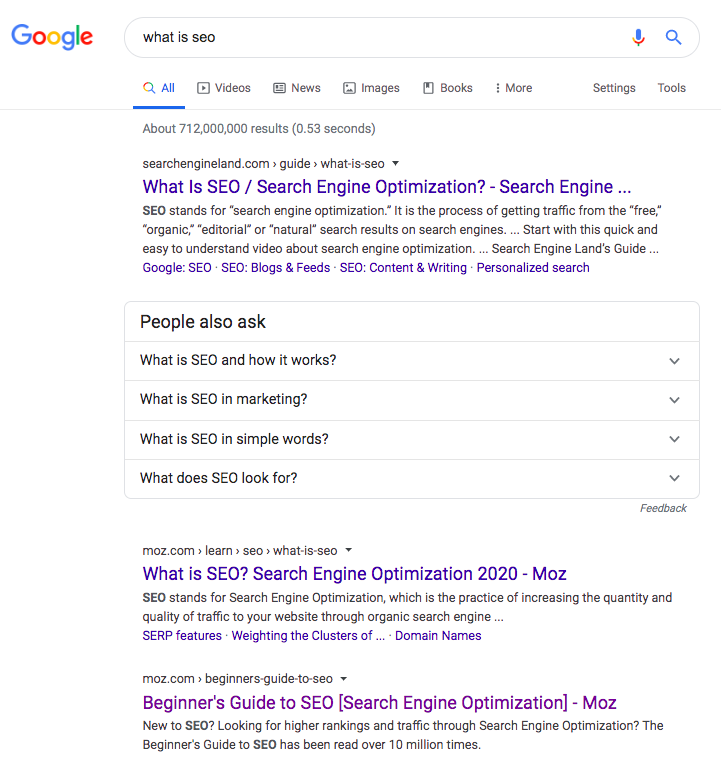
Snackable Content
Short-form textual or visual content such as short blog posts, infographics, and videos designed to succinctly convey the gist of the topic are often referred to as snackable content.
In these times of smaller screens and shorter attention spans, creating short and easily digestible content that reinforces your brand’s voice is a great idea.
Storytelling
Just because you’re a business owner or content marketer doesn’t mean that you don’t have a story to tell. Storytelling in content marketing is a powerful way of writing that involves a well-thought-out narrative that enables readers to relate on an emotional level to a business and see the benefits of its offerings.
Riveting stories engage prospects, ignite their emotions, and encourage brand loyalty.
Dive Deeper: 7 Examples of Storytelling Content You Can Use in Your Marketing Campaigns
Top of the Funnel (TOFU)
The top of the sales funnel (TOFU) refers to the “awareness” stage of the buyer’s journey in which the prospects have encountered your website or business for the first time. They are looking for more general information on a particular topic and potential solutions to their problems.
Publishing informative, educative and entertaining content can help guide them down the sales funnel to the next stages, eventually converting them into clients.
See above for Bottom of Funnel (TOFU) and Middle of the Funnel (MOFU).
Unique Pageviews
According to Google, “page views” as a metric is defined as the total number of pages viewed within a specific time period. “Unique page views” are the combined page views of a single user during the same session.
So if one user visits the same page three times in a single session, it will be measured as three page views but only one unique page view.
Unique Selling Proposition (USP)
The USP is what makes your product or service unique, and something that none of your competitors offer.
For example, take a look at these three shoe stores and see what makes each of them stand out:
- Zappos’ unique selling point is: free returns.
- Toms Shoes’ unique selling point is: for every pair of shoes a customer purchases, the company donates a pair to a child in need.
- Nike’s unique selling point is: high-quality athletic shoes with prominent sponsorships with star athletes.
User-Generated Content (UGC)
Any content that directly or indirectly markets your business and is not created by you (or your team) is called user-generated content or UGC. In other words, content such as blog posts, photos, memes, videos and GIFs created and posted online by your audience or customers who aren’t paid is UGC.
An Instagram photo of a customer using your product, a tweet mentioning your brand or a product review on Yelp all constitute UGC. This is more authentic than business-generated content, so it builds social proof and trust.
Dive Deeper: 8 Ways to Encourage More User-Generated Content (UGC)
Viral
This probably needs no explanation, but if your content goes “viral” on the Internet, it means that it has earned a lot of attention via social sharing (online word-of-mouth).
For example, if you create a meme related to your industry and it goes viral, it means that it’s so funny or clever or relevant or touching that everyone is compelled to share it on various social platforms, which earn your business a lot of attention and thus, traffic.
Dive Deeper: The A-to-Z of Viral Marketing (+ Infographic)
White Paper
A white paper is text-based content, often gated, that educates the audience by providing comprehensive analysis and research about a particular topic that your business is an expert in. It is usually offered as a downloadable resource in exchange for the prospect’s email address, converting them into a lead.
